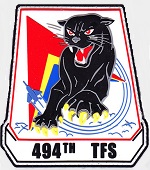Hobby Master HA3015 USAF General Dynamics F-111F "Aardvark" Strike Aircraft - 494th Fighter Squadron "Panthers", Colorado, 1992 (1:72 Scale)
"Obsolete weapons do not deter."
- British Prime Minister Margaret Thatcher
 The General Dynamics F-111 "Aardvark" is a medium-range interdictor and tactical strike aircraft that also fills the roles of strategic bomber, reconnaissance, and electronic warfare in its various versions. Developed in the 1960s and first entering service in 1967, the United States Air Force (USAF) variants were officially retired by 1998. The Royal Australian Air Force (RAAF) is the sole remaining operator of the F-111.
The General Dynamics F-111 "Aardvark" is a medium-range interdictor and tactical strike aircraft that also fills the roles of strategic bomber, reconnaissance, and electronic warfare in its various versions. Developed in the 1960s and first entering service in 1967, the United States Air Force (USAF) variants were officially retired by 1998. The Royal Australian Air Force (RAAF) is the sole remaining operator of the F-111.
The F-111 pioneered several technologies for production military aircraft including variable-sweep wings, afterburning turbofan engines, and automated terrain following radar for low-level, high-speed flight. Its design was influential, being reflected in later Soviet aircraft such as the Sukhoi Su-24, and some of its advanced features have since become commonplace. During its inception, however, the F-111 suffered a variety of development problems, and several of its intended roles, such as naval interception through the F-111B, failed to materialize.
In USAF service the F-111 has been effectively replaced by the F-15E Strike Eagle for medium-range precision strike missions, while the supersonic bomber role has been assumed by the B-1B Lancer. In 2007, the RAAF decided to replace its 21 F-111s in 2010 with 24 F/A-18F Super Hornets.
Pictured here is a 1:72 scale rendition of a USAF General Dynamics F-111F "Aardvark" strike aircraft that was attached to the 494th Fighter Squadron "Panthers", 48th Fighter Wing, then deployed to RAF Lakenheath, England, during 1992.
Sold Out!
Dimensions:
Wingspan: 12-1/4-inches
Length: 10-1/2-inches
Release Date: September 2014
 Historical Account "Panthers" - Beginning in late 1971, the 494th squadron started its conversion to the McDonnell Douglas F-4D Phantom II, with the aircraft being transferred from the 81st TFW at RAF Bentwaters. The conversion to the F-4D took several years, with the last F-100 departing in August 1974. With the arrival of the Phantoms, the F-4s adopted a common tail code of "LK". This tail code lasted only a few months as in July and August 1972 the 48th TFW further recoded to "LN".
Historical Account "Panthers" - Beginning in late 1971, the 494th squadron started its conversion to the McDonnell Douglas F-4D Phantom II, with the aircraft being transferred from the 81st TFW at RAF Bentwaters. The conversion to the F-4D took several years, with the last F-100 departing in August 1974. With the arrival of the Phantoms, the F-4s adopted a common tail code of "LK". This tail code lasted only a few months as in July and August 1972 the 48th TFW further recoded to "LN".
The F-4's service with squadron was short as operation "Ready Switch" transferred the F-4D assets to the 474th TFW at Nellis AFB Nevada. The 474th sent their General Dynamics F-111As to the 347th TFW at Mountain Home AFB Idaho, and the 347th sent their F-111Fs to Lakenheath in early 1977. Unlike the previous F-4 transition, the F-111 change took place quickly and without any significant problems. Almost immediately after changing aircraft, the squadron began a series of monthly exercises and deployments that took the Liberty Wing to Italy, Iran, Greece, and Pakistan.
The 494th also participated in Operation El Dorado Canyon, the air raid on Tripoli, Libya on April 14th-15th, 1986. It flew combat missions in Southwest Asia from, January-February 1991 as part of Operation Desert Storm
- General characteristics
- Crew: 2 (pilot and weapons system operator)
- Length: 73 ft 6 in (22.4 m)
- Wingspan:
- Spread: 63 ft (19.2 m)
- Swept: 32 ft (9.75 m)
- Height: 17.13 ft (5.22 m)
- Wing area:
- Spread: 657.4 ft² (61.07 m²)
- Swept: 525 ft² (48.77 m²)
- Airfoil: NACA 64-210.68 root, NACA 64-209.80 tip
- Empty weight: 47,200 lb (21,400 kg)
- Loaded weight: 82,800 lb (37,600 kg)
- Max takeoff weight: 100,000 lb (45,300 kg)
- Powerplant: 2× Pratt & Whitney TF30-P-100 turbofans
- Dry thrust: 17,900 lbf (79.6 kN) each
- Thrust with afterburner: 25,100 lbf (112 kN) each
- Zero-lift drag coefficient: 0.0186
- Drag area: 9.36 ft² (0.87 m²)
- Aspect ratio: spread: 7.56, swept: 1.95
- Performance
- Maximum speed: Mach 2.5 (1,650 mph, 2,655 km/h)
- Combat radius: 1,330 mi (1,160 nmi, 2,140 km)
- Ferry range: 4,200 mi (3,700 nmi, 6,760 km)
- Service ceiling: 66,000 ft (20,100 m)
- Rate of climb: 25,890 ft/min (131.5 m/s)
- Wing loading:
- Spread: 126.0 lb/ft² (615.2 kg/m²)
- Swept: 158 lb/ft² (771 kg/m²)
- Thrust/weight: 0.61
- Lift-to-drag ratio: 15.8
- Armament
- Guns: 1× M61 Vulcan 20 mm (0.787 in) gatling cannon (seldom fitted)
- Hardpoints: 9 in total (8× under-wing, 1× under-fuselage between engines)
- Armament capacity: 31,500 lb (14,300 kg) ordnance mounted externally on hardpoints and internally in fuselage weapons bay
- Bombs:
- Free-fall general-purpose bombs
- Mk 82 (500 lb/227 kg)
- Mk 83 (1,000 lb/454 kg)
- Mk 84 (2,000 lb/907 kg)
- Mk 117 (750 lb/340 kg)
- Cluster bombs
- BLU-109 (2,000 lb/907 kg) hardened penetration bomb
- Paveway laser-guided bombs, including:
- GBU-10 (2,000 lb/907 kg)
- GBU-12 (500 lb/227 kg)
- GBU-28, specialized 4,800 lb (2,200 kg) penetration bomb
- BLU-107 Durandal runway-cratering bomb
- GBU-15 electro-optical bomb
- AGM-130 stand-off bomb
Wingspan: 12-1/4-inches
Length: 10-1/2-inches
|


